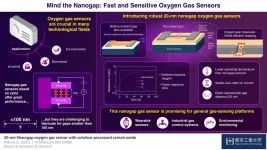Childhood cancer discovery may stop tumour spread before it starts
New understanding of how Ewing sarcoma tumours travel through the body has the potential to prevent metastatic spread in a number of cancer types
2021-06-01
(Press-News.org) A new discovery in Ewing sarcoma, an aggressive and often fatal childhood cancer, has uncovered the potential to prevent cancer cells from spreading beyond their primary tumour site.
The breakthrough provides new insight into what triggers the process that allows cancer cells to survive while traveling through the body in the bloodstream.
Researchers with the University of British Columbia and BC Cancer have learned that Ewing sarcoma cells--and likely other types of cancer cells--are able to develop a shield that protects them from the harsh environment of the bloodstream and other locations as they search for a new place to settle, or metastasize. The study has just been published in Cancer Discovery.
"You might think that a tumour cell could readily survive in the bloodstream, but it's actually a very harsh environment," said the study's senior author Dr. Poul Sorensen, a distinguished scientist at BC Cancer, professor of pathology and laboratory medicine and director of the faculty of medicine's newly-created Academy of Translational Medicine at the University of British Columbia.
"What we found was that Ewing sarcoma cells are able to develop an antioxidant response that shields them and allows them to survive as they circulate," said Dr. Sorensen. "This is similar to a person in the Arctic having to put a thick coat on before they go outside. If they don't shield themselves, they are exposed to dangerously harsh conditions under which they may not survive."
Metastatic disease, which occurs when cancer has spread throughout the body, is the single most powerful predictor of poor outcome for cancer patients of all ages and has been a difficult process for researchers to study or for clinicians to target.
"What's exciting about this study is if we can target the cells in circulation then maybe we can prevent metastasis from occurring. So that's the really big goal of this research," said Dr. Sorensen.
Not a lot of cells are able to become metastatic. While there has been research into genetic reasons a tumour mutates and spreads, what these researchers found is that Ewing sarcoma cells turn on the expression of a naturally-occurring gene on the surface of the cell, known as IL1RAP, to create a protein protective shield.
"This study is the first to show that the surface protein, IL1RAP, is rarely expressed in normal tissue, but is upregulated in childhood sarcomas" said Dr. Haifeng Zhang, a UBC postdoctoral fellow in Dr. Sorensen's laboratory at BC Cancer and first author of the study. "This is a really good thing because it means we can develop treatments to target IL1RAP without producing toxic side effects in non-cancer cells."
Drs. Sorensen and Zhang's colleagues, who are members of the St. Baldrick's Foundation-Stand Up To Cancer Pediatric Dream Team as well as the National Cancer Institute Pediatric Immunotherapy Discovery and Development Network (PI-DDN), have been developing antibodies that can target IL1RAP.
"These powerful antibodies can bind to the outside of the cell and we show in our research that these reagents can actually kill Ewing sarcoma cells. So not only have we discovered an interesting pathway, but we are well on our way to developing a clinical-grade immunotherapeutic treatment for Ewing sarcoma," said Dr. Sorensen.
"We are optimistic that we can work towards clinical trials in the next year or two," added Dr. Zhang.
Research is underway to investigate whether the same shielding behaviour can be found in other cancer cell types, including acute myeloid leukemia, melanoma, pancreatic adenocarcinoma, central nervous system tumours, and in some types of lung and breast cancers.
INFORMATION:
ELSE PRESS RELEASES FROM THIS DATE:
2021-06-01
TROY, N.Y. -- As more dissolved organic matter enters lakes across the northeast United States, darkening the lakes in a phenomena called "browning," new research shows that these waters may be growing less productive and able to sustain less life. In a study published today in Limnology and Oceanography Letters, scientists found that, rather than enriching lakes with nutrients as had previously been assumed, water more heavily laden with dissolved organic matter blocks sunlight and limits plant growth.
"A key question regarding lake browning is what impact it will have on aquatic food webs, including algal growth and fisheries," said Kevin Rose, co-author ...
2021-06-01
The brain is often likened to a computer: its hardware - neurons organized in complex circuits, its software - a plethora of codes that govern the neurons' behavior. But sometimes the brain performs exceptionally well even when its hardware seems inadequate for the task. For example, it's been puzzling how we and other mammals manage to navigate large-scale environments even though the brain's spatial perception circuits are seemingly suited to representing much smaller areas. A team of researchers from the Weizmann Institute of Science, led by Prof. Nachum Ulanovsky of the Neurobiology Department, tackled this riddle by thinking outside the experimental box. By combining an unusual research model - fruit bats - with an unusual setting - a 200 meters-long bat-tunnel - they were ...
2021-06-01
The genetic material of most organisms is carried by DNA, a complex organic molecule. DNA is very long -- for humans, the molecule is estimated to be about 2 m in length. In cells, DNA occurs in a densely packed form, with strands of the molecule coiled up in a complicated but efficient space-filling way. A key role in DNA's compactification is played by histones, structural-support proteins around which a part of a DNA molecule can wrap. The DNA-histone wrapping process is reversible -- the two molecules can unwrap and rewrap -- but little is known about the mechanisms at play. Now, by applying high-speed atomic-force microscopy (HS-AFM), Richard ...
2021-06-01
By ensuring ethnic diversity in a largescale genetic study, an international team of researchers, including a University of Massachusetts Amherst genetic epidemiologist, has identified more regions of the genome linked to type 2 diabetes-related traits.
The findings, published May 31 in Nature Genetics, broaden the understanding of the biological basis of type 2 diabetes and demonstrate that expanding research into different ancestries yields better results. Ultimately the goal is to improve patient care worldwide by identifying genetic targets to treat the chronic metabolic disorder. Type 2 diabetes affects and sometimes debilitates more than 460 million adults worldwide, according to the International Diabetes Federation. About 1.5 million deaths were directly ...
2021-06-01
The quality of a sewn garment is dependent on the quality of its seams that are the basic structural element. The factors affecting seam quality in garments include sewing thread type and stitch density. Making the right choice of these helps in getting quality seams in garments. However, the choice of suitable sewing threads and stitch densities for particular fabrics can only be determined through testing.
Dr. Patience Danquah Monnie, from the University of Cape Coast, Ghana, with fellow researchers, conducted research aimed to determine sewing thread brand and stitch density suitable for seams for a selected fabric (79% polyester and 21% cotton) for public basic school uniforms in Ghana. For the research, a 2×3 factorial ...
2021-06-01
Nitrates are critical for the growth of plants, so plants have evolved sophisticated mechanisms to ensure sufficient nitrate uptake from their environments. In a new study published in Nature Plants, researchers at Nagoya University, Japan, have identified a plant enzyme that is key to activating a nitrate uptake mechanism in response to nitrogen starvation. This finding explains how plants meet their needs in challenging environments, opening doors to improving agriculture in such environments.
When nitrate levels are plentiful in a plant's environment, a plant can achieve adequate nitrate uptake levels by relying ...
2021-06-01
Oxygen (O2) is an essential gas not only for us and most other lifeforms, but also for many industrial processes, biomedicine, and environmental monitoring applications. Given the importance of O2 and other gases, many researchers have focused on developing and improving gas-sensing technologies. At the frontier of this evolving field lie modern nanogap gas sensors--devices usually comprised of a sensing material and two conducting electrodes that are separated by a minuscule gap in the order of nanometers (nm), or thousand millionths of a meter. When molecules of specific gases get inside this gap, they electronically interact with the sensing layer and the electrodes, altering measurable ...
2021-06-01
The Yakushima sika deer (yakushika: Cervus nippon yakushimae), a subspecies of the Japanese sika deer (Cervus nippon), evolved without natural predators on the island of Yakushima, in Kagoshima Prefecture, Japan. It inhabits the forests on the island which were declared a World Heritage Site in 1993. Within the site, the yakushika has not been hunted in the past 50 years; however, since 2014, their population has been decreasing. This phenomenon is especially curious, as Japanese researchers believed that sika deer populations in Japan would not decrease without human intervention.
A group of three scientists, including Hokkaido ...
2021-06-01
Led by the University of Sydney's Charles Perkins Centre, the study looked at medical data from nearly half a million people and found having overweight or obesity considerably amplified the harmful effects of alcohol on liver disease and mortality.
"People in the overweight or obese range who drank were found to be at greater risk of liver diseases compared with participants within a healthy weight range who consumed alcohol at the same level," said senior author and research program director Professor Emmanuel Stamatakis from the Charles Perkins Centre and the Faculty of Medicine and Health.
"Even for people who drank within alcohol guidelines, participants classified as obese were at over 50 percent greater risk of liver disease."
The researchers ...
2021-06-01
Mussels survive by sticking to rocks in the fierce waves or tides underwater. Materials mimicking this underwater adhesion are widely used for skin or bone adhesion, for modifying the surface of a scaffold, or even in drug or cell delivery systems. However, these materials have not entirely imitated the capabilities of mussels.
A joint research team from POSTECH and Kangwon National University (KNU) - led by Professor Hyung Joon Cha and Ph.D. candidate Mincheol Shin of the Department of Chemical Engineering at POSTECH with Professor Young Mee Jeong and Dr. Yeonju Park of the Department ...
LAST 30 PRESS RELEASES:
[Press-News.org] Childhood cancer discovery may stop tumour spread before it starts
New understanding of how Ewing sarcoma tumours travel through the body has the potential to prevent metastatic spread in a number of cancer types






